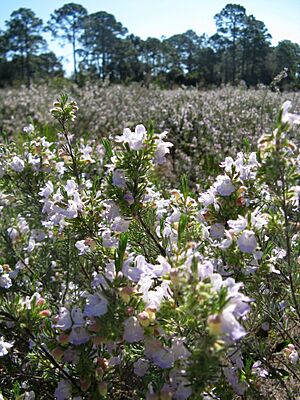Conradina facts for kids
Quick facts for kids Conradina |
|
|---|---|
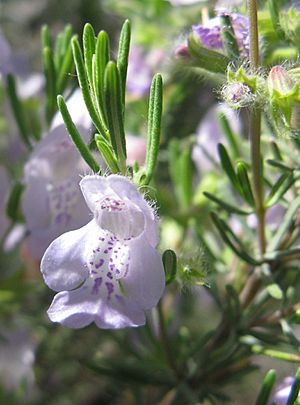 |
|
| False rosemary (Conradina canescens). Notice the tiny hairs on the flower cups. | |
| Scientific classification |
|
| Kingdom: | Plantae |
| Clade: | Tracheophytes |
| Clade: | Angiosperms |
| Clade: | Eudicots |
| Clade: | Asterids |
| Order: | Lamiales |
| Family: | Lamiaceae |
| Subfamily: | Nepetoideae |
| Tribe: | Mentheae |
| Genus: | Conradina Asa Gray |
| Type species | |
| Conradina canescens |
|
Conradina is a group of flowering plants in the mint family, called Lamiaceae. Its common name is false rosemary. Sometimes, it's also called short leaf rosemary.
There are 7 different kinds of Conradina plants. All of them grow naturally in the southeastern United States. One kind, Conradina verticillata, grows in Kentucky and Tennessee. The other kinds mostly grow in Florida. These plants are all very similar, and scientists are still studying if they are all truly separate species. Most Conradina plants like dry places with sandy soil that drains water well. The name Conradina was given by Asa Gray in 1870. It was named after an American plant expert, Solomon White Conrad.
False rosemary plants are good at living in sandy areas and open, bushy places. They are woody shrubs that live for many years. They often have lots of white or light purple flowers in spring or fall. These flowers attract different kinds of bees.
Conradina plants often look like small bushes. They grow near sand pines and oak trees. They can also be some of the first plants to grow in areas that have been disturbed. False rosemary plants release special chemicals called Terpenes. These chemicals stop grasses from growing nearby. This is thought to help prevent wildfires from spreading easily. These plants usually grow up to about 1 meter (3 feet) tall.
People have suggested using false rosemary in landscaping because it doesn't need much water. It can grow well even in poor soils, which is great for saving water in gardens.
False rosemary flowers and smells a lot like the herb Rosmarinus officinalis that you might use in cooking.
Scientists are now studying Conradina plants more. They are looking into their potential uses, like for essential oils and other helpful compounds.
Most Conradina species have 12 chromosomes in their reproductive cells. Scientists have done genetic research on Conradina to learn more about these plants.
Kinds of False Rosemary
Here are the different kinds of Conradina plants:
| Image | Scientific Name | Common Name | Where It Grows |
|---|---|---|---|
 |
Conradina brevifolia | Shortleaf false rosemary | This plant grows in Florida, especially in Polk and Highlands counties. It is an endangered species, meaning it's very rare and protected. |
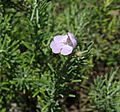 |
Conradina canescens | False rosemary | You can find this plant along the coast of Mississippi, Alabama, and Florida. It also grows in the sandy areas of central Florida. This is the most common kind of false rosemary. |
| Conradina cygniflora | This plant was discovered in 2009. It is only known to grow in Putnam County, Florida. | ||
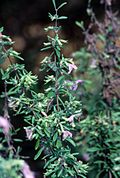 |
Conradina etonia | Etonia rosemary | This plant is only found in Putnam County, Florida. It is also an endangered species. |
 |
Conradina glabra | Apalacicola false rosemary | This plant only grows in Liberty County, Florida. It is another endangered species. |
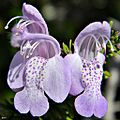 |
Conradina grandiflora | Largeflower false rosemary | This plant grows in counties along the Atlantic coast of Florida. It is listed as a threatened species in Florida. |
 |
Conradina verticillata | Cumberland false rosemary | This plant is a threatened species. It grows in the sandy soil near rivers on the Cumberland Plateau in Kentucky and Tennessee. |
Related Plants
Conradina is part of a group of mints that grow in the southeastern United States. These plants are all shrubs, except for one called Dicerandra. Conradina can be told apart from the others because its flower tube is sharply bent.
See also
 In Spanish: Conradina para niños
In Spanish: Conradina para niños


